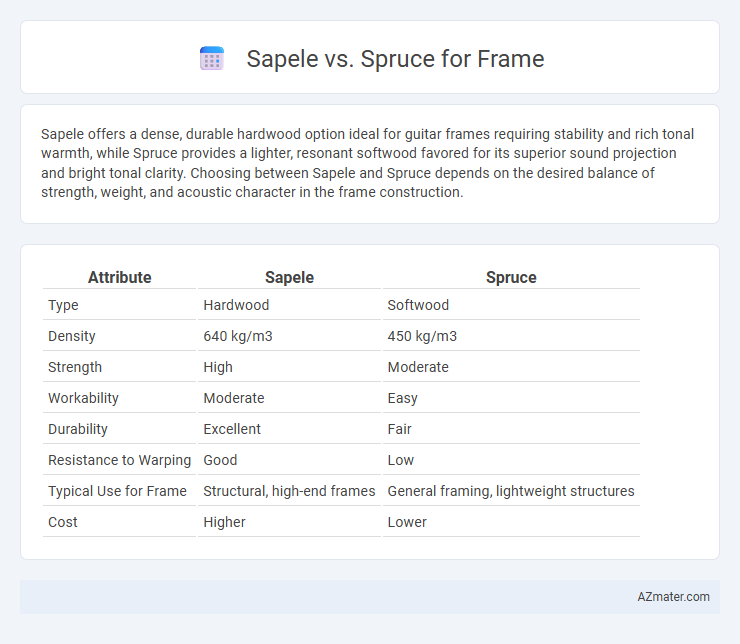Sapele offers a dense, durable hardwood option ideal for guitar frames requiring stability and rich tonal warmth, while Spruce provides a lighter, resonant softwood favored for its superior sound projection and bright tonal clarity. Choosing between Sapele and Spruce depends on the desired balance of strength, weight, and acoustic character in the frame construction.
Table of Comparison
| Attribute | Sapele | Spruce |
|---|---|---|
| Type | Hardwood | Softwood |
| Density | 640 kg/m3 | 450 kg/m3 |
| Strength | High | Moderate |
| Workability | Moderate | Easy |
| Durability | Excellent | Fair |
| Resistance to Warping | Good | Low |
| Typical Use for Frame | Structural, high-end frames | General framing, lightweight structures |
| Cost | Higher | Lower |
Introduction to Sapele and Spruce Woods
Sapele wood, a durable hardwood native to West Africa, offers a rich reddish-brown color and strong resistance to wear, making it ideal for structural frames requiring both strength and aesthetic appeal. Spruce, a lightweight softwood commonly sourced from Northern Europe and North America, provides excellent stiffness and easy workability, favored in frame construction where weight reduction and flexibility are important. Both woods serve crucial roles in framing, with Sapele excelling in durability and visual impact, while Spruce ensures efficient structural support and cost-effectiveness.
Key Physical Properties of Sapele
Sapele wood exhibits a density of approximately 640 kg/m3, significantly higher than spruce's density of around 450 kg/m3, providing enhanced strength and durability for framing applications. Its Janka hardness rating of 1,410 lbf surpasses spruce, making Sapele more resistant to dents and wear under heavy loads. The wood's natural interlocking grain structure increases its dimensional stability and resistance to warping compared to the straight-grain pattern found in spruce.
Key Physical Properties of Spruce
Spruce is a popular choice for framing due to its high strength-to-weight ratio, which provides excellent structural support while remaining lightweight. It features a straight grain and uniform texture, offering superior dimensional stability and ease of cutting compared to denser woods like Sapele. The wood's natural stiffness and resilience make it ideal for load-bearing applications in construction.
Durability and Longevity Comparison
Sapele wood offers superior durability with high resistance to decay and insect damage, making it a preferred choice for long-lasting frames in humid or outdoor environments. Spruce, while lighter and easier to work with, is less dense and more prone to wear and moisture-related deterioration over time. The longevity of Sapele frames typically exceeds that of Spruce, providing a stronger, more resilient structure in applications requiring extended service life.
Appearance and Grain Differences
Sapele wood features a rich reddish-brown hue with a fine, interlocking grain pattern that creates a ribbon-like effect, offering a warm and exotic appearance for frames. Spruce, in contrast, has a pale cream to light yellow color with a straight, uniform grain that provides a clean and classic look ideal for minimalist or traditional frames. The contrasting grain textures and coloration between Sapele and Spruce make each wood suited to different aesthetic preferences and design styles in framing applications.
Acoustic Qualities: Sapele vs Spruce
Sapele wood offers a warm, balanced tone with enhanced midrange frequencies, making it ideal for rich, resonant acoustic frames. Spruce is renowned for its bright, clear sound and excellent dynamic range, providing superior projection and responsiveness. When comparing Sapele vs Spruce, Spruce excels in delivering sharper attack and clarity, while Sapele provides a smoother, fuller sound profile.
Workability and Ease of Use
Sapele offers moderate workability with a fine, interlocked grain that can pose challenges when planing or sanding, requiring sharp tools for smooth finishes, whereas spruce is highly regarded for its exceptional ease of use due to its straight grain and soft texture, allowing for effortless cutting, shaping, and nailing. Spruce's lightweight nature reduces fatigue during extended framing tasks, making it a favorite for construction projects where quick assembly is essential. Sapele's durability and resistance to wear make it suitable for frames needing extra strength, but spruce provides superior workability for framers prioritizing speed and precision.
Environmental Impact and Sustainability
Sapele wood, a hardwood sourced primarily from West African tropical forests, has a higher environmental impact due to slower growth rates and concerns over deforestation and illegal logging. Spruce, commonly harvested from sustainably managed temperate forests, offers a more environmentally friendly option with faster growth and greater availability, supporting sustainable forestry practices. Choosing spruce for framing ensures better sustainability and reduced ecological footprint compared to sapele.
Cost Considerations for Frame Construction
Sapele wood commands a higher price compared to spruce due to its hardwood properties and durability, making it a costlier option for frame construction. Spruce is generally more affordable and widely available, offering a budget-friendly choice for large-scale framing projects. While sapele may reduce long-term maintenance costs with its resilience, initial savings typically favor spruce for cost-conscious builders.
Which Wood Is Best for Your Frame?
Sapele offers a rich, reddish-brown hue with excellent durability and resistance to warping, making it ideal for robust, long-lasting frames. Spruce is lighter in color and weight, prized for its straight grain and ease of machining, which suits delicate, intricate frame designs. Choosing between Sapele and Spruce depends on whether you prioritize strength and richness in appearance or lightweight flexibility and fine detail in your frame construction.

Infographic: Sapele vs Spruce for Frame
 azmater.com
azmater.com